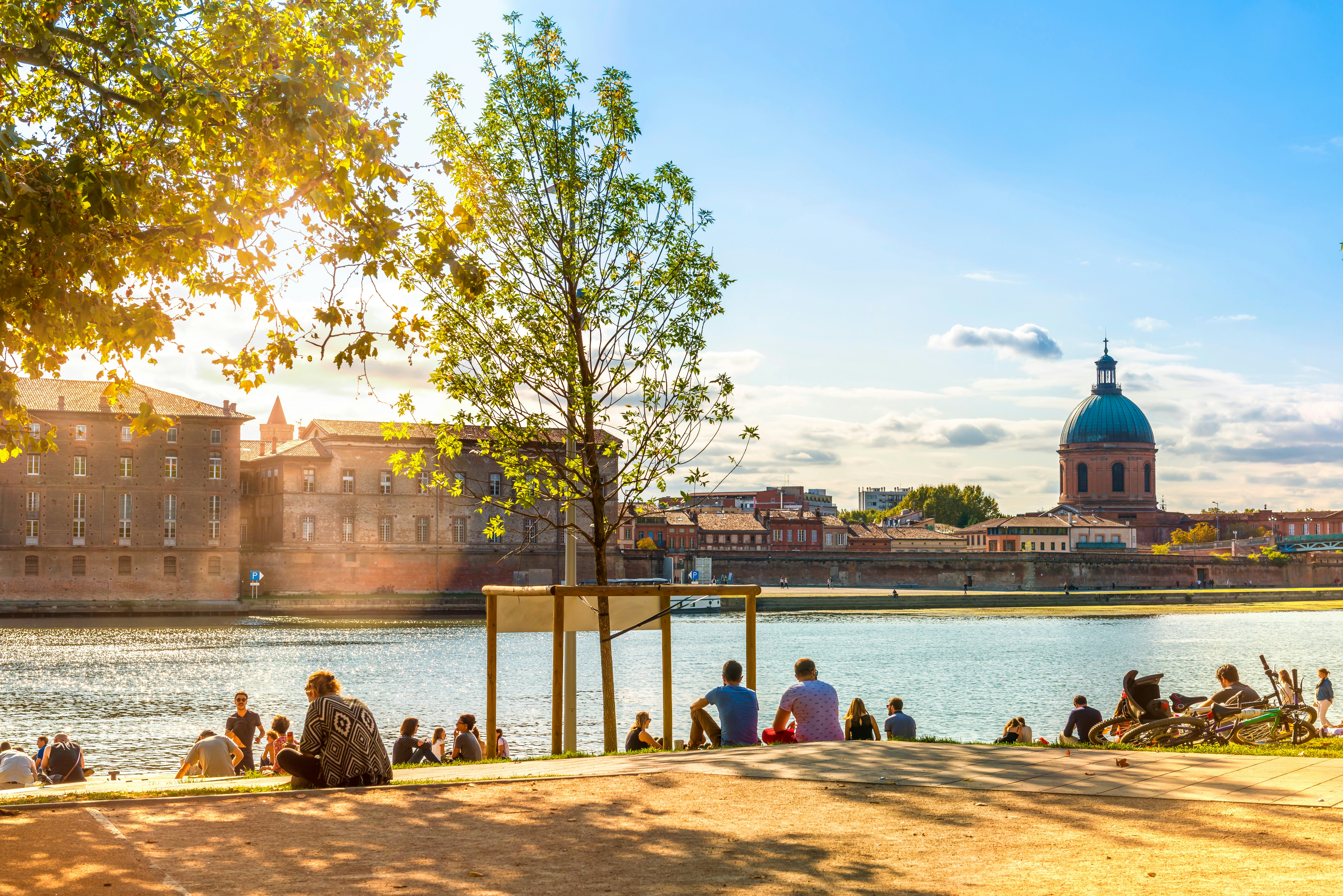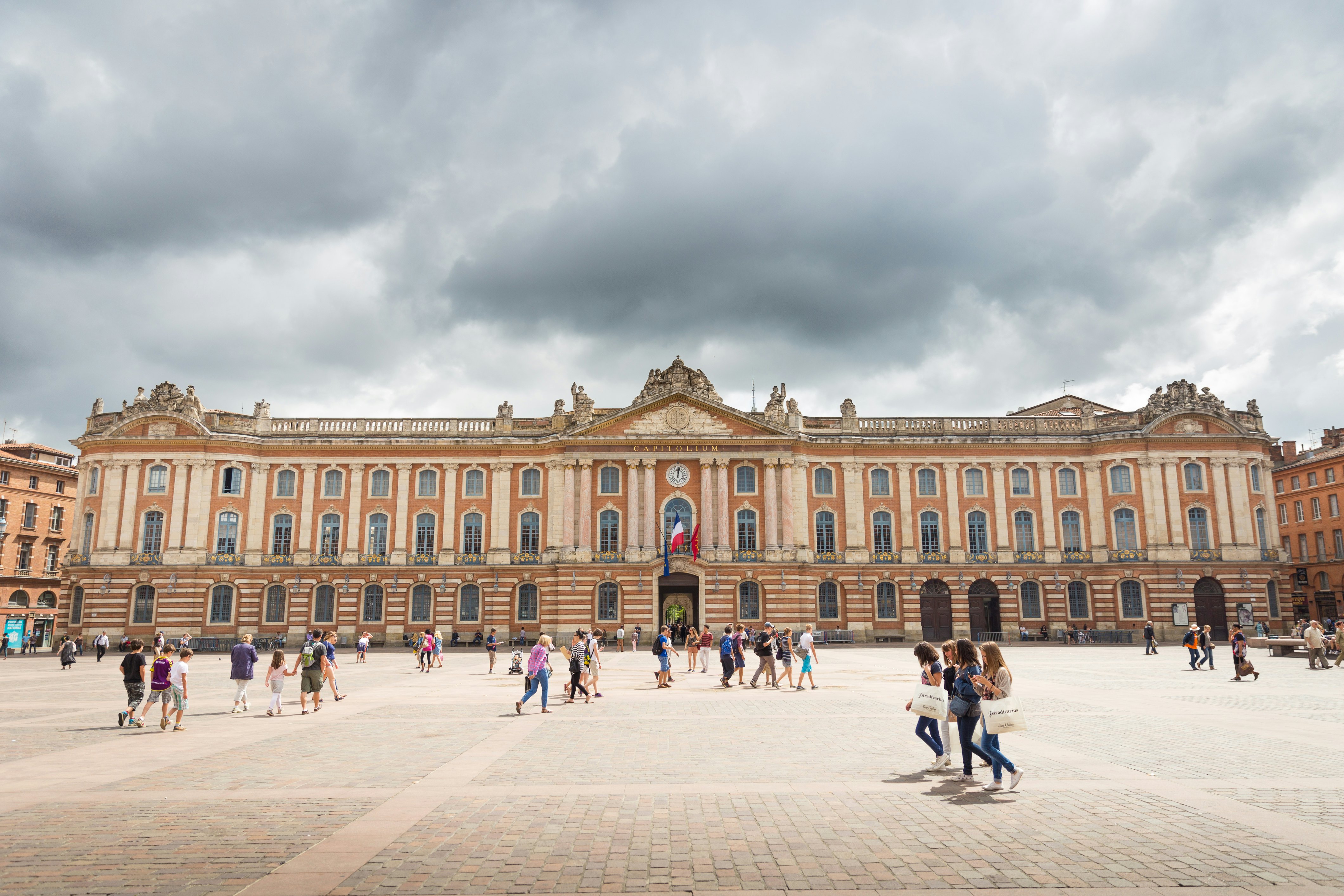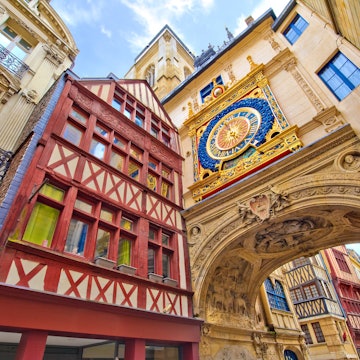

Cycling is a wonderful way to get to know Toulouse, France. Mario Guti/Getty Images
A student city with exceptional charm, Toulouse is a star on France’s long list of marvelous places to visit.
The so-called Ville Rose – a name derived from the pinkish-orange bricks of the city’s buildings – is at its most beautiful during spring and summer sunsets, when the sky and the city are draped in the same dreamy hue. There’s no better place to enjoy the tableau than from one of the city’s countless outdoors terrasses, over a glass of wine or pastis, the local aperitif.
Since many aspects of everyday life are designed with students in mind, Toulouse makes a great budget destination. A stroll stroll along the banks of the Garonne on a spring afternoon reveals impromptu concerts and popular group dance sessions in the fresh air.
Is Toulouse tempting you yet? Read on for all first-time visitors need to know about the town.

When should I go to Toulouse?
The best times to visit Toulouse are spring and autumn, when pleasant temperatures and long days make more optimal enjoyment of panoramic views of the Garonne river and alfresco cocktails. Fans of the golden hour and colorful photos will be very happy during these seasons. And these months usher in a packed calendar of cultural festivals, including the Rose Festival; Rio Loco and Le Week-End des Curiosités (music); Toulouse à Table (food); and more.
If you want to get the most out of the city, avoid midsummer weeks as the heat can be overwhelming and the city center is often empty.

Is it easy to get in and around Toulouse?
Perhaps it’s not surprising that the hometown of Airbus has terrific transport links. The city has two metro lines (a third is due to open in 2028) covering all the city’s neighborhoods and places of interest. Also, much of the city center is pedestrianized, and it’s very pleasant to get around by bike or bus, especially when sightseeing is your only agenda.
It doesn’t take long to reach France’s Atlantic and Mediterranean beaches, and the ski slopes of the nearby Pyrenees.
Top things to do in Toulouse

See the best of the city in an ambitious full-day tour
You can see the heart of Toulouse in one (packed) day. While the metro is easy to use, the pretty city is also perfect for cycling – a great way to admire all the pink buildings.
Get your day off to a gentle, serene start by relaxing for a moment on one of the benches of the Pierre-Baudis Japanese Garden at Compans-Caffarelli. A 20-minute walk (or shorter bike ride) takes you to Place du Capitole and City Hall, the heart of the Ville Rose, and its narrow neighboring streets.
Take a break at the Couvent des Jacobins, an oasis of palm trees and medieval architecture. Afterwards, you’re all set to discover the boutique-filled Carmes district – one of the city’s prettiest – via the Jardin des Plantes.
As the hour gets later, head for the quays of the Garonne via the Pont St-Pierre to take in the best light and color in the city. Before reaching the bridge, stop in at the famous 12th-century Hôpital de La Grave and its domed Chapelle St-Joseph, a powerful and beautiful symbol of Toulouse. For the best unfiltered sunset photos, head to the riverfront Espace EDF Bazacle, which has a breathtaking panorama.
Get your fill of Toulouse’s fabulous bar and restaurant scene
The pink city is renowned for its restaurants and bars. In particular, Rue Pargaminières and Port de la Daurade have some of the city’s top (and best-value) restaurants and terraces; the pub La Tireuse will delight all beer lovers. And don’t underestimate the popular guinguette (tavern) Pêcheurs de sable, with its shareable plates at very modest prices.
Right next door is Place St-Pierre, one of the best-known squares in all of France. At any of its lively bars (where the party goes well into the night), you can try a pastis, the South’s famous aperitif. Stop by Chez Tonton at happy hour to sip the liqueur for just €1.
Local tip: How do you drink a pastis? You have to dilute it with water – and always drink it with not one, not three, but exactly two ice cubes.

Marvel at mechanical monsters
Toulouse’s cultural and musical scene bubbles with activity. And perhaps the city’s most original cultural attraction is the Halle de la Machine and its Piste des Géants. Looming over you are giant bio-mechanical minotaurs and spiders that actually move and breathe, brought to life by expert machinists. These show monsters, which can weigh several tons, are the brainchild of a Nantes-based company, and make their home in Toulouse in between their world tours.
Take flight in Europe’s capital of aeronautics
Toulouse is a European bastion of aeronautics, home to multinationals the Airbus Group and Latécoère. This expertise is celebrated at Cité de l’Espace, a veritable treasure trove of knowledge for children and adults. Another Toulouse highlight is a visit to the Airbus headquarters and aircraft assembly plant on the outskirts of town. The nearby Aeroscopia Museum has as its centerpiece a real Concorde that you can examine up close.

How much money do I need for Toulouse?
Toulouse draws plenty of visitors, especially in spring and summer – but the prices don’t sting as they can in Paris or some coastal cities. The city boasts a wide range of quality hotels for all budgets; the inventory of short-term rentals grows in the peak season as many students and locals go on vacation.
Four-star hotel room for two: €150 (US$169) per night
Bed in a youth-hostel dormitory: €40 (US$45) per night
Self-catering apartment: €100 (US$113) per night
Car rental: from €45 (US$51) per day
Coffee: €2 (US$2.25)
Beer pint : €6 (€2.50 during happy hour) (US$6.75 / $2.82)
Unlimited-ride single-day metro ticket: €6.90 (US$7.80)
Fast-food menu: from €8 (US$9)
















